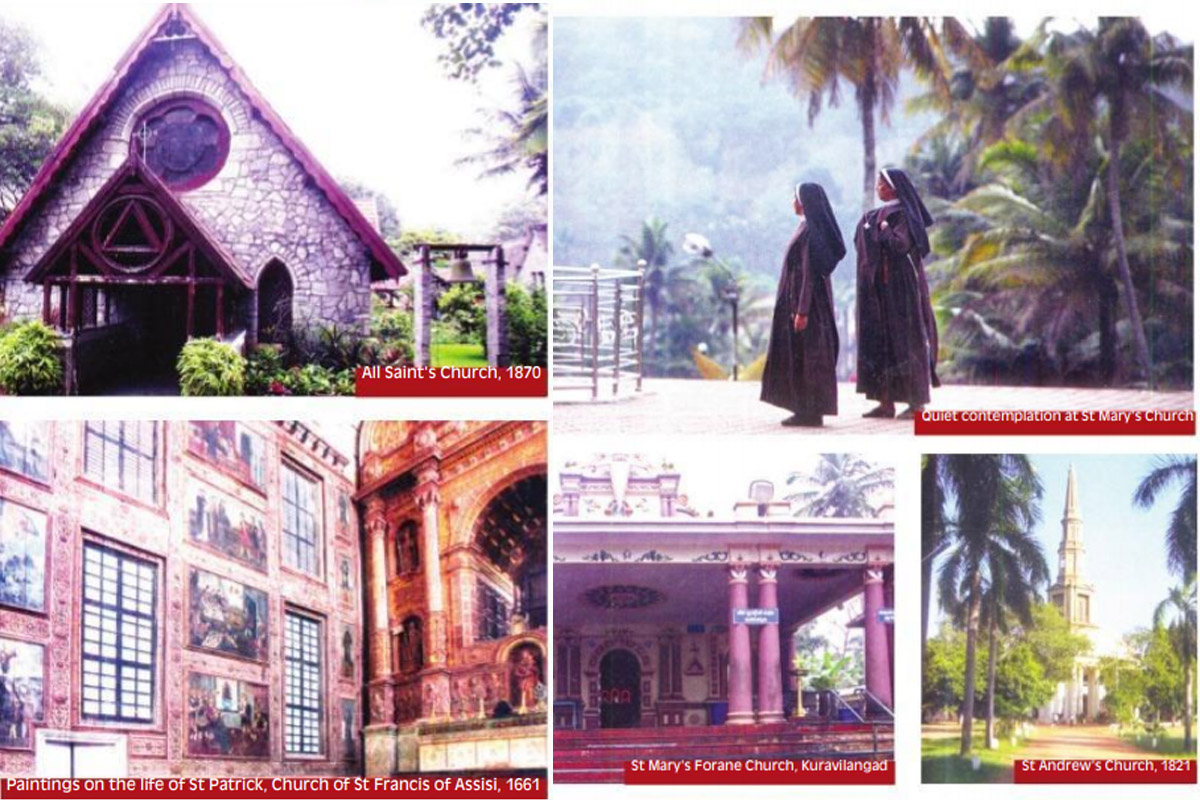Golden garden
The world of symbols we inhabit is unfortunately twice removed from reality, with “removed” being the operative word.
At a time when the sound of church bells ringing for Christmas and the New Year is slowly merging with the air of festivity, Joanne Taylors The Churches of India adds a unique flavour and generates interest in a topic thats both unusual and different.

Taylor’s tryst with India began many decades ago when she first visited the country in 1971 and which had a lasting impact. An accomplished writer and photographer, Taylor travelled widely in India, highlighting Bengal and Kolkata in particular. Her book The Forgotten Palaces of Calcutta (Niyogi Books, 2006) focussed on the heritage legacy of North Kolkata’s mansion, which seemed in dire need of maintenance and conservation. The Churches of India is her third book and reveals the history and architecture of the country’s Christian churches.
Published by Niyogi Books, this is a well-produced hard cover and priced Rs 1495. Generously packed with over 300 photographs and illustrations that highlight the evolution in architectural styles of churches, the dominating influences in different regions of the country over the centuries, there are few that are incredibly ancient and date back to the time of the “Common Era identified with the birth of Christ”. Taylor studied Indian history at the University of Sydney and wrote her thesis on “The Great Houses of Calcutta 1750 – 2006” for the University of New South Wales.
India is an enormous country, a conglomeration of many factors, reflecting diverse cultures, religions, communities and histories through the centuries. Much of this is reflected through its architecture, in the temples, mosques and last but not the least, churches. Taylor has rightly attributed to the fact that though India is home to Hindu temples and Islamic mosques, it also has an “extraordinary number of Catholic churches.”
Advertisement
Contrary to general perception, Christianity did not begin in India with colonisation but was initiated with the arrival of St Thomas the apostle in 52 AD, when he landed on the west coast of India. It was only after the Portuguese arrival in 1498 that church architecture became integrally linked with colonization.
Some regions have a profusion of churches like Kerala, while it’s difficult to spot one in Gujarat or Rajasthan. Taylor writes that this book was written for “readers interested in Indian history and church architecture” and comprises a diverse number from simple chapels to grand cathedrals. She also mentions that it would be “impossible to record all of India’s churches”.
The book explores the ancient beginnings, that “from the third or fourth centuries onward there is clear evidence of a Christian presence in Kerala”. Nonetheless St Thomas is regarded by many as the founding father of Christianity in India by both Christians and Hindus alike. As for the appearance of the churches in Kerala, Antonio de Gouvea wrote in 1599 that “the buildings were so small … that it was scarcely possible to raise the Holy Sacrament at the altar…”
The book has dedicated ample space for photographs to highlight diverse aspects and nuances of churches as they got built across the country.
It is more a detailed description of their evolution down the centuries than a narration of the spread of Christianity and that’s why it holds appeal to scholars keen to read about these places of worship.
Taylor has provided enough matter to go with the numerous pictures and maybe that’s one the reasons why such a book that encompasses almost everything in the category, includes this journey on churches from ancient times, of their history as they evolved in Kerala, Goa, Chennai, Mumbai, Delhi, Puducherry, Chandannagar, and Kolkata.
There are indispensable references for those wanting to probe further, of the many influences from the Dutch, Portuguese and French on the architecture.
There are descriptions and information of altars and chapels, stained glass windows, arches and columns, all of which are intrinsic to a church. We find many references to Mughal influences on tombs of eminent British persons such as Job Charnock.
Concurrent to the story of churches, Taylor also narrates India’s history as the country moved from colonial rule to freedom and Calcutta finds pride of place with its rich cultural heritage, being the erstwhile capital of British India, and its many ancient churches.
A small nugget of information is that the oldest church in Kolkata is not British, but Armenian, and dates back to 1724: the church of the Holy Nazareth is situated in North Kolkata.
Taylor has used an apt quote by leading architect Frank Lloyd Wright to ring in the conclusion, “Architecture is that great living creative spirit which from generation to generation, from age to age, proceeds, persists, creates, according to the nature of man, and his circumstances as they change. That is really architecture.”
In the author’s own words, “the architecture of India’s churches has been interpreted in different ways in different regions and at different times… The history of India’s fascinating churches is complex and there are other perspectives and more to tell.”
Advertisement